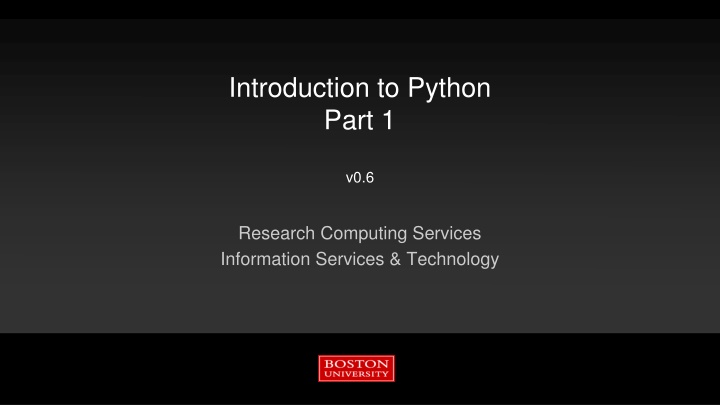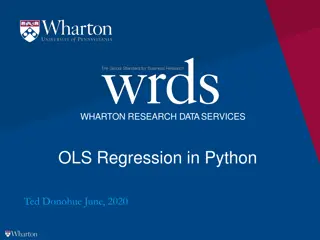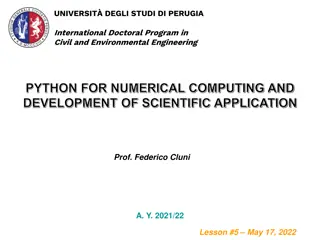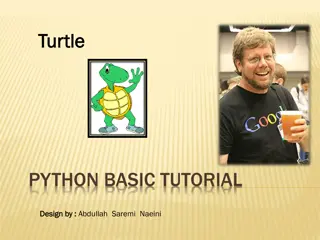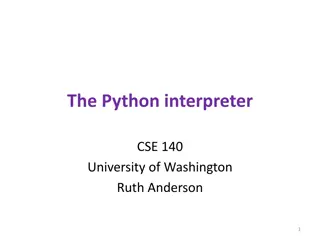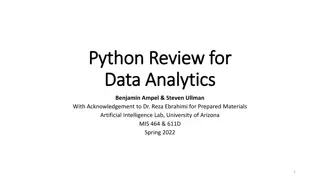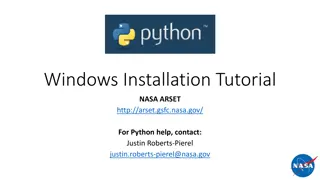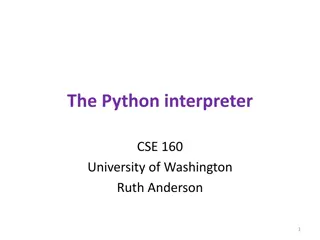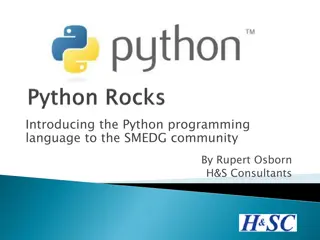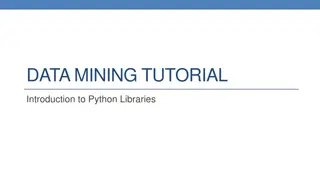Python Tutorial and Resources for Research Computing Services
Explore Python tutorial resources and services offered by Research Computing Services for scientific programmers, data analysis, visualization, and more. Learn how to access Python for tutorials and installation instructions. Get started with Python for research computing today!
Download Presentation

Please find below an Image/Link to download the presentation.
The content on the website is provided AS IS for your information and personal use only. It may not be sold, licensed, or shared on other websites without obtaining consent from the author.If you encounter any issues during the download, it is possible that the publisher has removed the file from their server.
You are allowed to download the files provided on this website for personal or commercial use, subject to the condition that they are used lawfully. All files are the property of their respective owners.
The content on the website is provided AS IS for your information and personal use only. It may not be sold, licensed, or shared on other websites without obtaining consent from the author.
E N D
Presentation Transcript
Introduction to Python Part 1 v0.6 Research Computing Services Information Services & Technology
RCS Team and Expertise Our Team Scientific Programmers Systems Administrators Graphics/Visualization Specialists Account/Project Managers Special Initiatives (Grants) Maintains and administers the Shared Computing Cluster Located in Holyoke, MA ~19,000 CPUs running Linux Consulting Focus: Bioinformatics Data Analysis / Statistics Molecular modeling Geographic Information Systems Scientific / Engineering Simulation Visualization CONTACT US: help@scc.bu.edu
SCC Python Tutorials Introduction to Python, Part one Introduction to Python, Part two Numerical and Scientific Computing in Python Python for Data Analysis Data Visualization in Python Introduction to Python Scikit-learn
About You Working with Python already? Have you used any other programming languages? Why do you want to learn Python?
Running Python for the Tutorial If you have an SCC account, log onto scc4 and use Python there. Run: module load python3/3.6.5 spyder & /scratch/Intro_Python_code_0.4.sh
Links on the Rm 107 Terminals On the Desktop open the folders: Tutorial Files RCS_Tutorials Tutorial Files Introduction to Python Copy the whole Introduction to Python folder to the desktop or to a flash drive. When you log out the desktop copy will be deleted!
Run Spyder Click on the Start Menu in the bottom left corner and type: spyder After a second or two it will be found. Click to run it. Be patient it takes a while to start.
Running Python: Installing it yourself There are many ways to install Python on your laptop/PC/etc. https://www.python.org/downloads/ https://www.anaconda.com/download/ Intel Python
BUs most popular option: Anaconda https://www.anaconda.com/download/ Anaconda is a packaged set of programs including the Python language, a huge number of libraries, and several tools. These include the Spyder development environment and Jupyter notebooks. Anaconda can be used on the SCC, with some caveats.
Python 2 vs. 3 Python 2: released in 2000, Python 3 released in 2008 Python 2 is in end-of-life mode no new releases or patches after Dec 31, 2019 No library support (e.g. pandas, numpy, etc.) after that date Py3 is not completely compatible with Py2 For learning Python these differences are almost negligible Which one to learn? Python 3 If your research group / advisor / boss / friends all use one version that s probably the best one for you to choose. If you have a compelling reason to focus on one vs the other
SCC Python Versions Python3 python3/3.6.5(default) python3/3.7.3 python3-intel/2019.4.088 Python2 python2/2.7.16 python2-intel/2019.4.088
Spyder a Python development environment Pros: Faster development Easier debugging! Helps organize code Increased efficiency Cons Learning curve Can add complexity to smaller problems
The Spyder IDE Variable and file explorer editor Python console
Tutorial Outline Part 1 What is Python? Operators Variables Functions Classes If / Else
Tutorial Outline Part 2 Lists Tuples and dictionaries Modules numpy and matplotlib modules Script setup Development notes
Tutorial Outline Part 1 What is Python? Operators Variables Functions Classes If / Else
What is Python? Python is a general purpose interpreted programming language. is a language that supports multiple approaches to software design, principally structured and object-oriented programming. provides automatic memory management and garbage collection is extensible is dynamically typed. By the end of the tutorial you will understand all of these terms.
Some History Over six years ago, in December 1989, I was looking for a "hobby" programming project that would keep me occupied during the week around Christmas I chose Python as a working title for the project, being in a slightly irreverent mood (and a big fan of Monty Python's Flying Circus). Python creator Guido Van Rossum, from the foreward to Programming Python (1st ed.) Goals: An easy and intuitive language just as powerful as major competitors Open source, so anyone can contribute to its development Code that is as understandable as plain English Suitability for everyday tasks, allowing for short development times
Interpreted Languages (ex. Python or R) Python interpreter: follows bytecode instructions bytecode conversion Source code files prog.py math.py Python interpreter python prog.py A lot less work is done to get a program to start running compared with compiled languages! Python programs start running immediately no waiting for the compiler to finish. Bytecodes are an internal representation of the text program that can be efficiently run by the Python interpreter. The interpreter itself is written in C and is a compiled program.
Comparison Interpreted Faster development Easier debugging Debugging can stop anywhere, swap in new code, more control over state of program (almost always) takes less code to get things done Slower programs Sometimes as fast as compiled, rarely faster Less control over program behavior Compiled Longer development Edit / compile / test cycle is longer! Harder to debug Usually requires a special compilation (almost always) takes more code to get things done Faster Compiled code runs directly on CPU Compiler can optimize more extensively More control over program behavior
The Python Prompt The standard Python prompt looks like this: The IPython prompt in Spyder looks like this: IPython adds some handy behavior around the standard Python prompt.
Tutorial Outline Part 1 What is Python? Operators Variables Functions Classes If / Else
Operators Python supports a wide variety of operators which act like functions, i.e. they do something and return a value: Arithmetic: + - * / % ** Logical: and or not Comparison: > < >= <= != == Assignment: = Bitwise: & | ~ ^ >> << Identity: is is not Membership: in not in
Try Python as a calculator Go to the Python prompt. Try out some arithmetic operators: + - * / % ** == ( ) Can you identify what they all do?
Try Python as a calculator Go to the Python prompt. Try out some arithmetic operators: + - * / % ** == () Operator Function + Addition - Subtraction * Multiplication / Division (Note: 3 / 4 is 0.75!) % Remainder (aka modulus) ** Exponentiation == Equals
More Operators Try some comparisons and Boolean operators. True and False are the keywords indicating those values:
Comments # is the Python comment character. On any line everything after the # character is ignored by Python. There is no multi-line comment character as in C or C++. An editor like Spyder makes it very easy to comment blocks of code or vice- versa. Check the Edit menu
Tutorial Outline Part 1 What is Python? Operators Variables Functions Classes If / Else
Variables Variables are assigned values using the = operator In the Python console, typing the name of a variable prints its value Not true in a script! Visualize Assignment Variables can be reassigned at any time Variable type is not specified Types can be changed with a reassignment
Variables contd Variables refer to a value stored in memory and are created when first assigned Variable names: Must begin with a letter (a - z, A - Z) or underscore _ Other characters can be letters, numbers or _ Are case sensitive: capitalization counts! Can be any reasonable length Assignment can be done en masse: x = y = z = 1 Multiple assignments can be done on one line: x, y, z = 1, 2.39, 'cat' Try these out!
Variable Data Types Python determines data types for variables based on the context The type is identified when the program runs, called dynamic typing Compare with compiled languages like C++ or Fortran, where types are identified by the programmer and by the compiler before the program is run. Run-time typing is very convenient and helps with rapid code development but requires the programmer to do more code testing for reliability. The larger the program, the more significant the burden this is!
Variable Data Types Available basic types: Numbers: Integers and floating point (64-bit) Complex numbers: Strings, using double or single quotes: Boolean: True and False Lists, dictionaries, and tuples These hold collections of variables Specialty types: files, network connections, objects or x = complex(3,1) x = 3+1j "cat" 'dog' Custom types can be defined using Python classes.
Variable modifying operators Some additional arithmetic operators that modify variable values: Operator x += y x -= y Effect Add the value of y to x Subtract the value of y from x Multiply the value of x by y Divide the value of x by y Equivalent to x = x + y x = x - y x *= y x = x * y x /= y x = x / y The += operator is by far the most commonly used of these.
Check a type A built-in function, type(), returns the type of the data assigned to a variable. It s unusual to need to use this in a program, but it s available if you need it! Try this out in Python do some assignments and reassignments and see what type() returns.
Strings Strings are a basic data type in Python. Indicated using pairs of single '' or double "" quotes. Multiline strings use a triple set of quotes (single or double) to start and end them.
Tutorial Outline Part 1 What is Python? Operators Variables Functions Classes If / Else
Functions Functions are used to create code that can be used in a program or in other programs. The use of functions to logically separate the program into discrete computational steps. Programs that make heavy use of function definitions tend to be easier to develop, debug, maintain, and understand.
Python functions Function name Optional comma-separated list of arguments (incoming variables) Keyword def A code block Optional return statement The return value can be any Python type If the return statement is omitted a special None value is still returned. The arguments are optional but the parentheses are required! Functions must be defined before they can be called.
Which code sample is easier to read? float avg(int a, int b, int c) { float sum = a + b + c ; return sum / 3.0 ; } float avg(int a, int b, int c){ float sum = a + b + c ; return sum / 3.0 ;} C: or Matlab: function a = avg(x,y,z) a = x + y + z ; a = a / 3.0 ; end function a = avg(x,y,z) a = x + y + z ; a = a / 3.0 ; end or
Which code sample is easier to read? float avg(int a, int b, int c) { float sum = a + b + c ; return sum / 3.0 ; } Most languages use special characters ({ } pairs) or keywords (end, endif) to indicate sections of code that belong to: Functions Control statements like if Loops like for or while C function a = avg(x,y,z) a = x + y + z ; a = a / 3.0 ; end Matlab Python instead uses the indentation that programmers use anyway for readability.
The Use of Indentation Python uses whitespace (spaces or tabs) to define code blocks. Code blocks are logical groupings of commands. They are always preceded by a colon : def avg(x,y,z): all_sum = x + y + z return all_sum / 3.0 def mean(x,y,z): return (x + y + z) / 3.0 A code block Another code block This pattern is consistently repeated throughout Python syntax. Spaces or tabs can be mixed in a file but not within a code block.
Function Return Values A function can return any Python value. Function call syntax: A = some_func() Another_func() b,c = multiple_vals(x,y,z) # some_func returns a value # ignore return value or nothing returned # return multiple values Open function_calls.py for some examples
Function arguments Function arguments can be required or optional. Optional arguments are given a default value def my_func(a,b,c=10,d=-1): some code To call a function with optional arguments: Optional arguments can be used in the order they re declared or out of order if their name is used. my_func(x,y,z) my_func(x,y) my_func(x,y,d=w,c=z) # a=x, b=y, c=z, d=-1 # a=x, b=y, c=10, d=-1 # a=x, b=y, c=z, d=w
Garbage collection Variables defined in a function (or in any code block) no longer have any live references to them once the function returns. These variables become garbage Python s garbage collectionoperates to remove them from the computer s memory, freeing up the memory to be re-used. There is no need to explicitly destroy or release most variables. Some complex data types provide .close(), .clean(), etc. type functions. Use these where available.
When does garbage collection occur? It happens when Python thinks it should. For the great majority of programs this is not an issue. Programs using very large quantities of memory or allocating large chunks of memory in repeated function calls can use more memory than expected. If you are having trouble with memory usage contact RCS for help!
Tutorial Outline Part 1 What is Python? Operators Variables Functions Classes If / Else
Classes OOP: Object Oriented Programming In OOP a class is a data structure that combines data with functions that operate on that data. An object is a variable whose type is a class Also called an instance of a class Classes provide a lot of power to help organize a program and can improve your ability to re-use your own code.
Object-oriented programming Python is a fully object oriented programming (OOP) language. Some familiarity with OOP is needed to understand Python data structures and libraries. Object-oriented programming (OOP) seeks to define a program in terms of the things in the problem (files, molecules, buildings, cars, people, etc.), what they need, and what they can do. You can write your own Python classes to define custom data types.
Object-oriented programming Class Car OOP defines classes to represent the parts of the program. Classes can contain data and methods (internal functions). public interface Classes can inherit from one another A class (the subclass) can use all of the data and methods from another class (the superclass) and add its own. This is a highly effective way of modeling real world problems inside of a computer program. private data and methods
